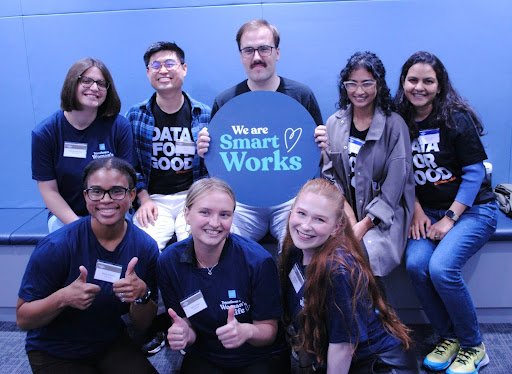Getting women into work with Smart Works
By Nicole Holgate, Communications Manager at DataKind UK
“The project was an incredible, transformational experience for our charity. It gave us the opportunity to get the most out of our data, create clear next steps, and look at different areas to improve on.”
Emma King, Smart Works team member
Meet Smart Works
Smart Works exists to inspire and empower women who need help getting into work. From its 11 centres across the UK, it provides interview and career coaching, alongside high-quality workwear, to help women enter the workplace. Of the women they work with, over half are from an ethnic minority, more than a third are lone parents, and nearly half have been unemployed for over a year.
Their challenge
With over 632,500 unemployed women in the areas where they operate, Smart Works knew they were not reaching all of the women who could benefit from their support, and struggled to identify where there were gaps in their provision.
It is vital to Smart Works’ outreach strategy to discover where there are unemployed women who they aren’t reaching, and where they should focus their efforts next. To guide these decisions, they wanted to compare the information they gathered about their current clients to an overall picture of women’s unemployment in the UK. It was also important to them to identify any particular demographics they might be under- or over-serving when compared to national unemployment data.
Knowing this would help them to develop their future strategy, and get more women back into the workforce.
The project
Smart Works wanted to assess national need, especially looking for Local Authorities that had a high number of unemployed women but low numbers of Smart Works clients. They also wanted to identify any particular demographic groups, such as age or ethnicity, that they might not be reaching. This would show them where their centres might not be fully supporting the communities they are based in, or where they could consider opening new centres.
Data approaches
Together, we mapped publicly available ‘open data’ from the Census 2021 and Annual Population Survey to show women’s unemployment rates by Local Authority. We compared this to the number of Smart Works clients in each Local Authority. Using the same data sets, we also compared the demographics of Smart Works’ clients to the overall demographic groups of unemployed women.
What did they find out?
A screenshot of an interactive map showing Smart Works’ centre locations as black icons, overlaid on a map of female unemployment rates (light to dark green), to investigate how well the centres were serving local areas.
The analysis showed Smart Works several Local Authorities with high unemployment where they had low numbers of existing clients. By looking for potential clients by age, they also discovered high unemployment in young women, who they do not seem to be reaching.
They began outreach work to cover these areas from their existing centres with immediate success, finding many more women who needed their support. Their grants team is using the insights to raise more funding to tackle this gap.
Smart Works also raised these high levels of youth unemployment with the Department of Work and Pensions, and has since teamed up with Job Centres nationally to ensure more young women get their support.
"These findings have allowed us to specifically target those that are most in need of our service."
Melissa Pittman, Head of Data and Impact
What happens next?
Now that they have seen how to extract and use external data sets, the Smart Works team feels confident about repeating this comparative analysis. Their data has been cleaned and restructured so referrals can be more easily tracked over time. They can ensure their understanding of national need is informed by up-to-date data, so that ultimately, they can help more women into employment.
“I absolutely cannot recommend it enough! The volunteers were incredibly hardworking and knowledgeable. The findings will be at the heart of Smart Works' referral strategy moving forward.”
Melissa Pittman, Head of Data and Impact



